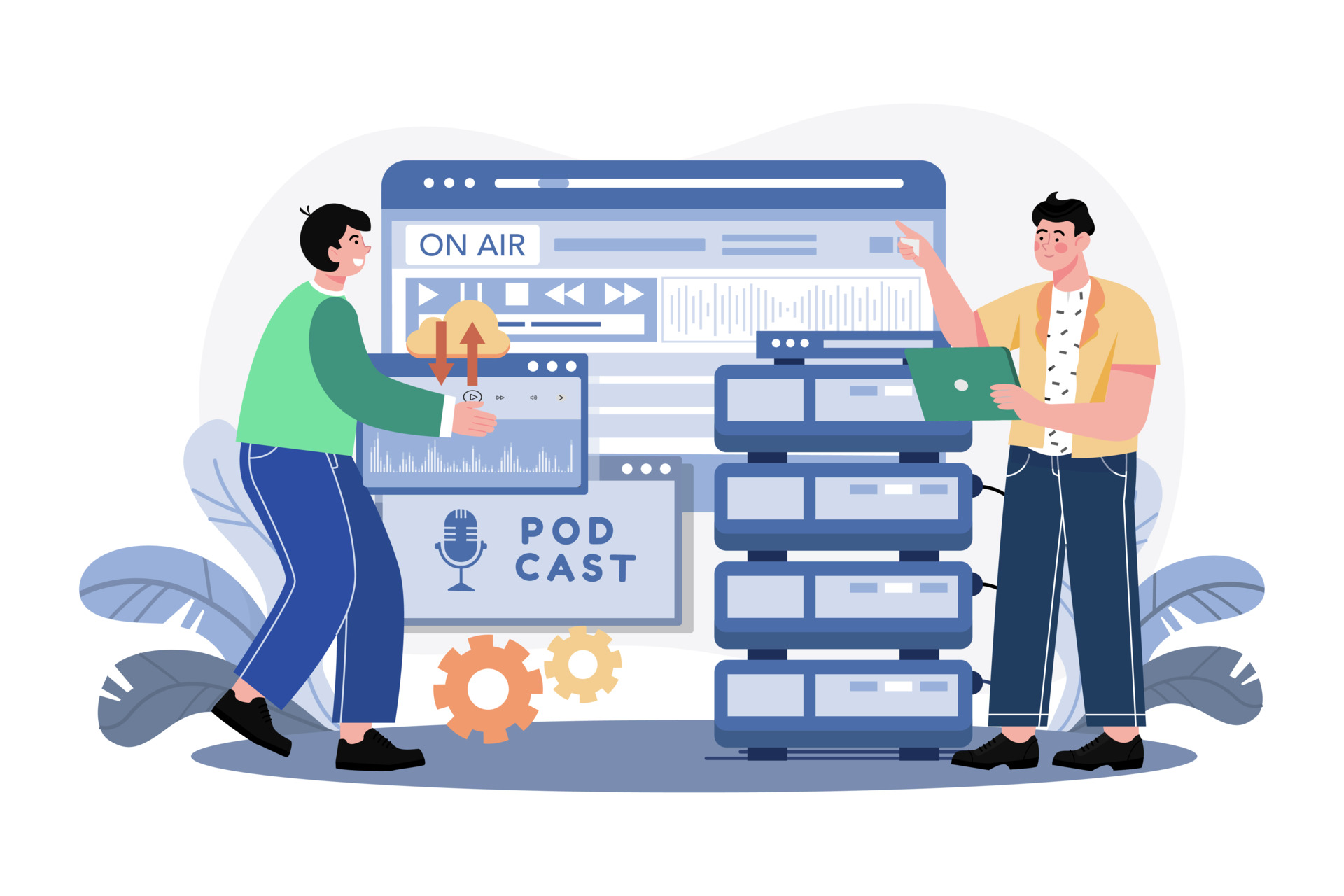In 2023, podcasts continue to skyrocket as a powerful medium for sharing knowledge, stories, and insights. As an aspiring podcaster, you’re probably wondering how to produce and distribute business podcasts to create a top-notch podcast that stands out in this competitive landscape.
Worry not, as this comprehensive guide will walk you through every step, from choosing the right topic and format to promoting and monetizing your podcast. Are you ready to make your voice heard?
Key Takeaways
- Choose the right topic and format for your business podcast.
- Identify your target audience and select a suitable podcast format.
- Invest in professional equipment, software, hosting platforms, distribution channels & strategies to promote & monetize content successfully.
Choosing the Right Topic and Format for Your Business Podcast
The foundation of a successful podcast lies in selecting an appropriate topic and format that align with your brand, ideal audience, and unique perspective.
You should carefully consider factors such as niche, style, and tone to make your podcast resonate with your audience and stand out among thousands of podcasts available online.
Remember, the key is to create your own podcast that provides value, entertainment, or both, while staying true to your brand’s identity. One way to achieve this is by focusing on the quality of each podcast episode.
Identifying Your Target Audience
To create a podcast that truly engages your listeners, you need to do the following:
- Identify your target audience. This involves understanding their demographics, preferences, and pain points.
- Craft content that resonates with your audience and addresses their specific needs.
- Build an engaged and loyal audience who are more inclined to share your podcast with others, aiding its growth.
Once you have a clear understanding of your ideal audience, focus on creating content that appeals to their interests and hobbies. Keep track of their challenges and the solutions they seek to ensure you’re continuously providing value. Remember, an audience-centric approach is the key to a successful podcast.
Selecting a Podcast Format
After identifying your target audience, it’s time to choose a format that suits your style and goals. There are various podcast formats to consider, such as:
- Solo
- Co-hosted
- Interview-based
- Narrative
Each format comes with its own advantages and disadvantages, hence, the importance of selecting a format that aligns with your objectives and promotes effective engagement with your listeners.
Experimenting with different formats in your initial episodes can also help you determine which one works best for you and your audience.

Essential Equipment and Software for Podcast Production
For a professional and polished podcast sound, it is necessary to invest in essential equipment and software. A high-quality microphone, headphones, and reliable recording and editing tools are crucial components that can make or break your podcast.
Remember, even the most captivating content can be overshadowed by poor sound quality, so prioritize this aspect when setting up your podcast.
Microphone Selection
Selecting the appropriate microphone is a critical step towards achieving clear and consistent audio quality. Factors such as budget, recording environment, and the type of microphone best suited for your podcast should all be considered.
Investing in a quality microphone will not only enhance your podcast’s audio quality, but also ensure that your listeners have an enjoyable and immersive experience.
Recording and Editing Software
Choosing the right recording and editing software is key to a smooth production process. Options like Audacity, GarageBand, or Adobe Audition cater to different needs and budgets.
Choose a software that aligns with your technical expertise and provides the features necessary for your podcast. Keep in mind that user-friendly software can make the entire process more enjoyable and efficient, allowing you to focus on creating engaging content.

Creating Engaging Podcast Episodes
Creating engaging podcast episodes requires:
- Thorough research
- Planning
- Scripting
- A focus on structure and storytelling
Striking a balance between delivering valuable information and entertaining your listeners is of great importance.
This can be achieved by adopting a conversational tone, incorporating anecdotes, and using real-life examples to illustrate your points. Remember, an engaged listener is more likely to become a loyal fan and recommend your podcast to others.
Research and Planning
Before diving into the production of the podcast, devote sufficient time to research and planning. This involves gathering information on your chosen topic, outlining key discussion points, and identifying the most logical order to present them in.
A well-researched and planned episode not only ensures that your content is insightful and valuable, but also helps you maintain a smooth narrative flow, keeping your listeners engaged from start to finish.
Moreover, preemptive episode planning allows for a consistent publishing schedule, a key factor in building and maintaining audience trust.
Consistency also enables you to establish a strong brand identity and become a reliable source of information in your niche, further strengthening your podcast’s credibility.
Scripting and Structuring Episodes
During episode planning, you should focus on scripting and structuring. A well-structured episode helps maintain a coherent narrative flow, keeping your listeners engaged and informed throughout.
Be mindful of your audience’s preferences and attention span while scripting your episodes, ensuring you strike a balance between providing valuable information and keeping the content entertaining.
In addition to scripting your episodes, consider incorporating various storytelling techniques to enhance your podcast’s narrative and make it more engaging. Some techniques to consider include:
- Using anecdotes to provide real-life examples and personal experiences that relate to your topic
- Using metaphors and analogies to help explain complex concepts in a more relatable way
- Maintaining a conversational tone to make your podcast feel more like a friendly conversation with your listeners
By incorporating these storytelling techniques, you can make your podcast more relatable and enjoyable for your listeners.

Selecting a Podcast Hosting Platform and Distribution Channels
Choosing a podcast hosting platform and distribution channels that best fit your needs is fundamental to reaching a broad audience. A reliable hosting platform will store and stream your audio files, generate and manage your podcast’s RSS feed, and submit your podcast to various directories.
Distribution channels like the Apple Podcasts app, Spotify, and Google Podcasts enable your podcast to be easily accessible to listeners, increasing your chances of gaining new fans and growing your audience.
Podcast Hosting Services
Selecting a podcast hosting service like Podbean, Buzzsprout, or Libsyn is an essential step in making your podcast accessible to listeners.
As a podcast host, these services store and stream your podcast audio files, generate and manage your podcast’s RSS feed, also known as the podcast feed, and submit your podcast to a podcast directory, as well as various podcast directories. To simplify the process, consider exploring different podcast hosting sites to find the perfect fit for your needs.
Choosing a hosting service should take into account your needs in terms of storage, bandwidth, pricing, reliable customer support, and a user-friendly interface.
Distribution Channels
Utilizing distribution channels like:
- Apple Podcasts
- Spotify
- Google Podcasts
- YouTube
Can make your podcast easily accessible to a wide range of listeners. These platforms offer various features and benefits to podcasters, such as analytics, promotion tools, and integration with social media.
By making your podcast available on multiple distribution channels, you increase the chances of reaching new listeners and growing your audience.
Remember, the more accessible your podcast is, the more likely it is to attract a loyal following.

Promoting and Growing Your Business Podcast
Growing and promoting your business podcast requires the use of diverse channels and strategies, including:
- Social media marketing
- Audiograms
- Collaborations
- Networking within the podcast community
These efforts can help increase your podcast’s visibility, attract new listeners, and foster engagement with your existing audience.
Keep in mind that promoting your podcast is an ongoing process that requires consistency, creativity, and adaptability to ensure continuous growth.
Social Media Marketing
Social media platforms offer a powerful means to:
- Share your episodes, snippets, and behind-the-scenes content with a wide audience
- Engage with your existing audience
- Attract new listeners
- Receive valuable feedback on your content
- Showcase your podcast’s personality and brand identity
By leveraging these platforms, you can stand out from the competition and run a successful social media marketing campaign for your podcast.
Creating engaging, shareable, and visually appealing content is vital when using social media for podcast promotion.
Posting regularly, interacting with your audience, and utilizing platform-specific features, such as Instagram Stories or Twitter polls, can help you build a strong online presence and grow your podcast’s following.
Collaborations and Networking
Collaborating with influencers, guest speakers, and other podcasters can significantly expand your podcast’s reach and audience.
By partnering with individuals or organizations within your niche, you can leverage their expertise, networks, and audiences to:
- Grow your podcast
- Enhance your content
- Build valuable relationships within the podcasting community
- Open doors to future opportunities and partnerships
Networking within the podcasting community can be as simple as joining online forums, attending industry events, or engaging with fellow podcasters on social media.
These connections can lead to valuable insights, feedback, and potential collaborations, all of which can contribute to your podcast’s growth and success.
Exploring various podcast networks can also be a great way to expand your reach and discover new opportunities.

Monetizing Your Business Podcast
Monetizing your business podcast presents a rewarding opportunity to generate income while sharing your expertise and passion with your audience. There are various monetization strategies to consider, such as:
- Sponsorships
- Advertising
- Premium content
- Subscriptions
It’s essential to choose a monetization approach that aligns with your podcast’s niche, scope, and objectives while maintaining transparency and ethical practices.
Sponsorships and Advertising
Securing sponsorships and advertising deals is a potential source of steady revenue for your podcast and can contribute to audience growth.
It’s important to align your sponsorships and advertising with your podcast’s content and audience to ensure a seamless integration of promotional material.
This can help maintain your listeners’ trust and prevent any potential backlash or negative impact on your podcast’s reputation.
When seeking sponsorships and advertising deals, follow these steps.
- Research potential sponsors and advertisers that resonate with your audience and niche.
- Be prepared to showcase your podcast’s value, reach, and engagement to demonstrate the benefits of partnering with your podcast.
- Remember, successful sponsorships and advertising deals can lead to long-term partnerships and increased revenue for your podcast.
Premium Content and Subscriptions
Offering premium content and subscriptions can be another effective way to monetize your podcast. By providing exclusive access to bonus episodes, ad-free listening, or other perks, you can generate additional revenue while cultivating a more committed and devoted audience.
This strategy can also help you identify your most loyal and engaged listeners, allowing you to tailor your content and promotional efforts accordingly.
When implementing premium content and subscriptions, it’s essential to strike a balance between offering exclusive benefits and maintaining the quality and accessibility of your free content.
Ensuring that your premium offerings provide genuine value and align with your audience’s needs and preferences can help you successfully monetize your podcast while maintaining your listeners’ trust and loyalty.

Staying Updated on Podcasting Trends and Opportunities
As the world of podcasting continually evolves, keeping abreast of current trends and opportunities is key to maintaining relevance and promoting growth.
Adapting to emerging technologies, platforms, and audience needs can help you enhance your podcast’s production, distribution, and monetization capabilities.
By staying informed about the latest developments in the podcasting industry, you can continuously improve your podcast and ensure it remains a valuable and engaging resource for your audience.
Emerging Technologies and Platforms
Keeping an eye on emerging technologies and platforms can help you identify new tools and opportunities that could enhance your podcast’s production, distribution, or monetization.
This might include experimenting with new recording equipment, embracing new distribution channels, or adopting innovative promotional strategies.
Being open to innovation and change can help you stay ahead of the curve and maintain a competitive edge in a saturated podcast market.
In addition to new technologies and platforms, staying updated on industry trends and best practices can help you refine your podcast’s format, content, and promotional strategies.
By staying informed about the latest trends and adapting your podcast accordingly, you can ensure it remains engaging, relevant, and appealing to your audience.
Adapting to Audience Needs
For a podcast to maintain its success, it must continuously adapt to the needs and preferences of its audience. This may involve:
- Adjusting your podcast’s content
- Changing the format
- Updating promotional strategies
- Aligning with changing listener behaviors, interests, or feedback
By staying in tune with your audience, you can create a podcast that continuously evolves and grows alongside them.
To effectively adapt to your audience’s needs, it’s essential to maintain open lines of communication and gather regular feedback. This can help you:
- Identify areas of improvement
- Uncover new opportunities
- Create a podcast that resonates with your audience
- Drive long-term success.
Summary
In conclusion, producing a successful business podcast in 2023 requires a combination of strategic planning, quality production, effective promotion, and continuous adaptation.
By following this comprehensive guide, you’ll be well-equipped to create a podcast that stands out in the crowded landscape and resonates with your ideal audience.
So why wait? Start your podcasting journey today and make your voice heard!
Frequently Asked Questions
How are podcasts distributed?
Podcasts are typically distributed via RSS feed to multiple directories through a podcast hosting provider.
Many podcast distribution platforms, such as Podbean, Podcast Websites and Spreaker, can also be used to make the process easier.
How do I make and distribute a podcast?
To make and distribute a podcast, upload audio files to a podcast hosting service, submit your show to various podcast directories such as iTunes/Apple Podcast and Spotify, and share episode players from your hosting platform on your website.
Additionally, promote your podcast through social media platforms and relevant hashtags.
How do you structure a business podcast?
To structure a business podcast, begin with an introduction and some intro music, followed by an interview recorded online, then conclude with a summary of the show and outro music.
Introduce the podcast with an interesting story or anecdote to draw in the listener. This should be followed by a brief overview of the topics that will be discussed in the episode.
The interview should be conducted in a conversational style, allowing the guest to share.
How is a podcast produced?
Podcast production involves planning, recording, editing and publishing.
Recording is done with quality equipment and audio is edited using software like Audacity or Descript.
Finally, the podcast is published to reach listeners.
What are the essential equipment and software for podcast production?
Creating a successful podcast requires having the right equipment and software; a good microphone, headphones, and an audio editor like Audacity, GarageBand, or Adobe Audition are essential.
Having the right tools is only the first step; you also need to know how to use them. Researching tutorials and watching YouTube videos can help you get up to speed quickly.
Finally, you need to have a plan for your podcast. Decide.